Arquus celebrated its first anniversary with two Technodays dedicated to innovation
On May 23 and 24, 2019, Arquus organized two Technodays on the historic Linas-Montlhéry autodrome (circuit). Placed under the sign of the exchange, these two days aimed at confronting the current work of the engineers of Arquus and the glance of the French state and industrial partners of the company.
VAB Mk.3, Czech-made Taros UGV, remotely controlled Dagger, Scarabee demonstrator, some of the innovations Arquus chose to demonstrate (Army Recognition video coverage copyright)
As CEO Emmanuel Levacher explained, innovation is inseparable from the Arquus philosophy. The history of the company is indeed the one of visionary engineers who have revolutionized the design, industrialization or conceptual implementation of vehicles of their time, whether the 1st World war FT-17 tank or the AML (AutoMitrailleuse Légère), the revolutionary EBR (Engin Blindé de Reconnaissance) or the VAB (Véhicule de l’Avant Blindé). Innovation is an obligation that keeps a leg up on the opponent, and to guarantee the company's customers, starting with the French Army, the best products at the best price.
The innovation applied to the support also makes it possible to guarantee the operational technical availability of the equipment, at all times and in all conditions. The multiplicity of needs and doctrines also requires the provision of equally reliable solutions, whatever the complexity of the expressed need. This requires from Arquus a growing spirit of adaptation, under a growing economic constraint.
During these 2019 Technodays, Arquus presented the results of its engineers' research in fields as varied as energy management, propulsion, automation, maintenance or additive manufacturing. This research effort is complemented by the transposition and integration of selected innovations developed by the Volvo AB Group, which represents a valuable industrial asset, especially in terms of automated driving, electromobility and connectivity.
Arquus reaffirms its philosophy of innovation thanks to its 500 or so researchers. The company works, often on own funds, to develop practical applications for the military, aiming to simplify the use and logistics of the equipment while reducing energy expenditure and the cost of vehicles. Arquus also innovates by improving what already exists, by working on mechanics, tools, ergonomics, daily management, in order to facilitate the work of operators and maintenance personnel of tomorrow. For Arquus, innovation is reflected in a perpetual challenge, and in the search for simpler, more economical solutions. To optimize its results, the company works with several partners of different sizes, including start-ups and universities.

Scarabee demonstrator, the "star" of the Arquus Technodays, showing its four-wheel steering system at work (Picture source: Arquus)
The Scarabee, an impressive technology demonstrator
The main subject of attraction for these Technodays was the Scarabee, a light armored diesel-electric hybrid vehicle that is still in the demonstrator stage, as it combines innovations to validate one after the other. The scale model of the vehicle had been revealed confidentially to a limited number of privileged people at Eurosatory 2018.
As Emmanuel Levacher explained to Army Recognition, this machine was developed on own funds in just nine months by a team of six (originally) and later up to less than twenty people. An accomplishment! It was necessary to validate one by one different possible uses before continuing the progression. Objective: to later propose a competitor in the program of the future Armored Vehicle of Assistance to the Commitment (Véhicule Blindé d’Aide à l’Engagement, VBAE) which will succeed the VBL (Véhicule Blindé Léger, Light Armored Vehicle) and VB2L. The size of the Scarabee is a little larger than that of the VBL but its versatility, transport capacity and modularity will be much greater. Replying to a question asked by Army Recognition, it is not yet amphibious but this ability is considered; its batteries - which can be reloaded very quickly - can already be fully immersed and the roof air intake protects the engine from any wet breaks (it already prevents clogging of the radiator by mud and sand).
It is unclear where to begin the comments on the design of the vehicle, so much there is material to write: the squat form limited to 1.90m high, the driver in the center front seat, the three soldiers’ seats in the rear center position, in front of the engine compartment, the sliding doors (replaceable by conventional doors on request) electrically or manually operated and partially opening the roof to facilitate fast access and exit of loaded occupants, the formidable 4x4x4 transmission which allows the vehicle to move conventionally or sideways (in “crab”) and turn with a less than 5-meter radius, options that are also found on the Defenture of the Dutch Special Forces (for the record, tests imposed in 1942 to Willys and Ford with a limited number of prototypes of their respective four-wheel-drive Jeep had caused so many accidents that the option was abandoned). The front wheels are controlled by a conventional steering wheel, while the rear wheels are, for the moment, controlled by a joystick but everything will later be gathered in the steering wheel. Asked by Army Recognition, the driver replied that it had taken him only two hours to master the behavior of the Scarabee in all the variety of management possibilities. In addition to a direct view of almost 180 °, the driver has two cameras that complete a 360° vision.
The ground clearance is adjustable between 40 and 50 cm. The tires identical to those of the Sherpa will of course be equipped with an inflation / deflation system.
Arquus did not reveal the level of protection of the vehicle. The demonstrator exposed to Technodays is also not yet armored. However, it has a double floor and may (a more and more frequent option) receive additional armor kits adapted to the dangerousness of each mission. In total, the mass of the Scarabee will be about 8 tons, including 2 tons of payload. Three vehicles can be loaded into an Airbus A400M Atlas.
Regarding its armament, the Scarabee can receive a remote controlled weapon station armed with a .50 machine gun or a 30mm gun, for instance. Other possibilities: a grenade launcher, a radar, etc., the roof can be adapted to many options.
The engine of the Scarabee was designed as a diesel-electric hybrid, with a 300 hp engine and a 75 kW electric motor powered by two Li-Ion batteries, a combination that takes advantage of tests conducted with the VAB Mk.3 Electer that was also exposed at the Technodays. This formula offers a weight/power ratio that is half more than the Sherpa Light’s one. Electric propulsion can operate in four modes: hybrid, boost by cumulating the electric and diesel propulsion modes, electric alone to reduce the thermal and sound footprint, and generator to power or reload other systems, a requirement that we found on a growing number of military vehicles of all sizes, including the U.S. special forces’ Polaris MRZX buggy.
An asset that will greatly relieve the mechanics and some logisticians, the engine is fixed on a sliding rack, which will provide better accessibility during the maintenance and replacement phases. This formula appeared for the first time in 1952 on the American M75 APC, a predecessor of the M113. This system allows the replacement of the engine in less than 45 minutes.
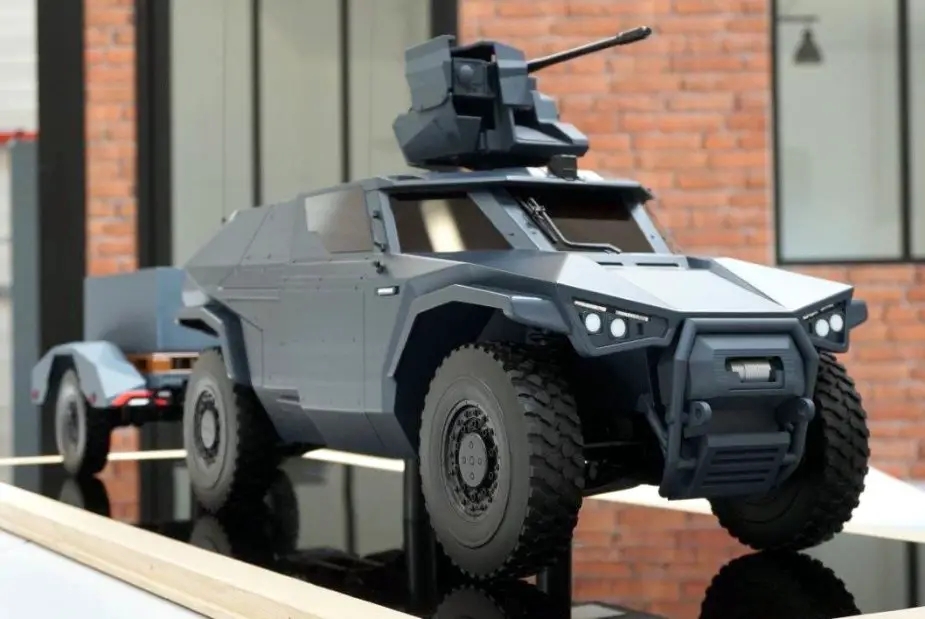
Scarabee and its "Engin d'Allègement au Contact" (Picture source: Arquus)
A great project of Arquus, a very sophisticated trailer is planned to be towed by the Scarabee. But it will be infinitely more than a trailer, as its capabilities will be varied. Arquus does even not designate it a "trailer" but “Engin d’Allègement au Contact” (EAC, approximatively Contact Ligthening Vehicle/Device) because it will have its own electric motorization: the two main wheels of the EAC are each equipped with an electric motor powered by Li-Ion batteries. In difficult terrain, these engines will be added to those of the Scarabee to avoid compromising the performance of the latter. The batteries will be, as on some hybrid civilian vehicles, reloaded by the energy generated downhill by braking. With its third retractable wheel, it will be more or less a kind of multi-purpose UGV designed to support the crew of the Scarabee in its missions. Detachable by an operator from inside the Scarabee, this EAC can evolve alone, remotely controlled or preprogrammed, combined with other EACs evolving in convoy, be equipped as a cargo mule, transport of wounded, armed platform, etc. The list of options is long.
The Scarabee will know many more exciting developments to watch.
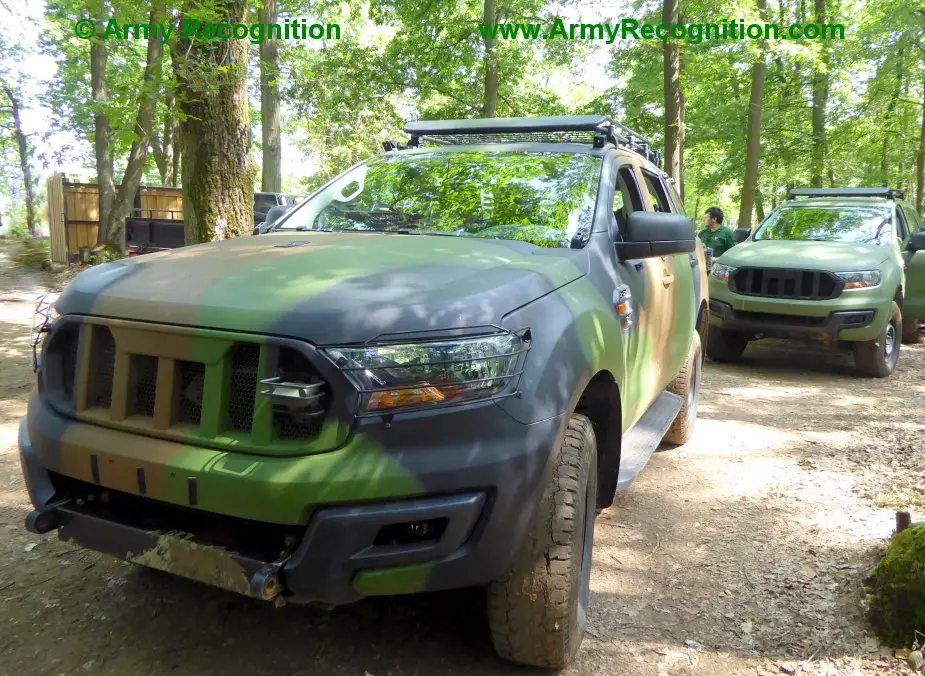
Off-road demonstrations of the VT4, the new liaison vehicle of the French army, took pléce in a wood (Picture source: Army Recognition)
VT4 liaison vehicle
The VT4, the successor of the Peugeot P4, was also displayed and explained by Arquus engineers. 600 modifications have been brought to the original Ford Everest SUV (the removed original parts are destroyed, following an agreement with Ford to avoid disturbing the spare parts market). The 6-cylinder engine has been downgraded from Euro 6 to Euro 3 specification to enable it to work even in operation on harsh external theaters of operation (a special derogation has been granted by the French government to allow these vehicles to drive in France, despite the environmental restrictions imposed to all the other vehicles). Let’s notice that the radio wiring benefits from jamming protection.

Emmanuel Levacher, CEO of Arquus, gave an excellent overview of the many innovation fields currently explored by Arquus (Picture source: Arquus)
Other innovations by Arquus
Arquus had displayed several workshops to explain what the various divisions are working on. Automation is an important research area. Arquus benefits from the Volvo group's achievements and combines them with his own: driver automation (level 1), partial automation (level 2) and high automation (level 4). All Arquus platforms are now predisposed to robotization. The patents accumulate, in particular in the technologies adapted to unstructured environments, as civil technologies are unadapted, even the GPS). Thousands of different "noises" have been tested with the sensors to ensure they do not compromise the progress of a convoy remotely controlled from a lead and back vehicles. The convoy must keep following the road. This system is not intended for use in traffic conditions but rather for logistical convoys between ports and airports. It works in infrastructure free, GNSS (GPS) denied and environment agnostic (any type of environment) conditions. Many scenarios have already been tested with the Arquus Convoy System.
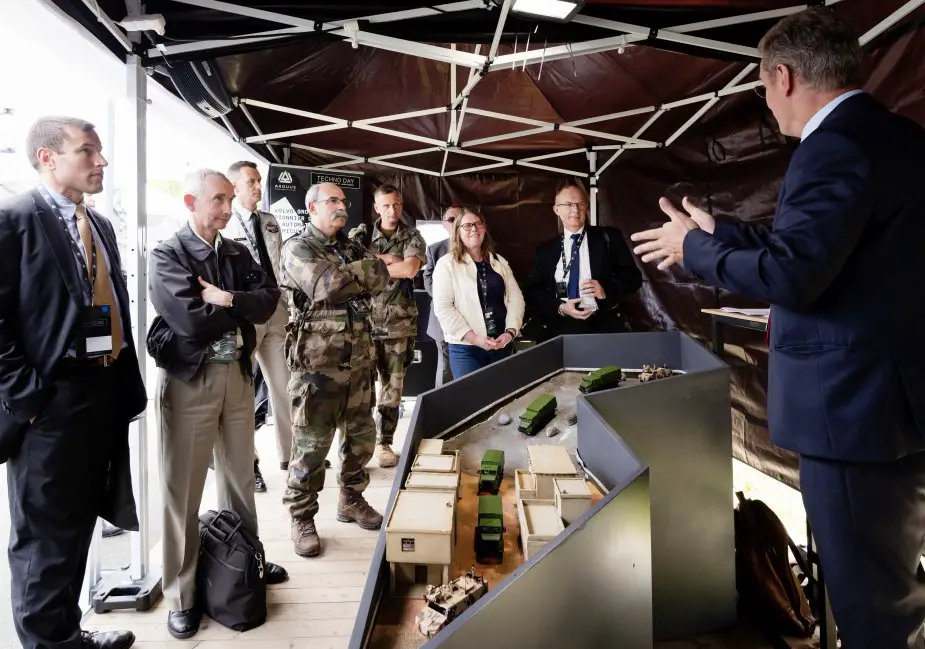
Explanation of the convoy automation system in one of the workshops (Picture source: Arquus)
Demonstrations of a remotely controlled Dagger armored 4x4 vehicle have been made. The current French regulation still imposes the presence of someone on board but the vehicle can evolve alone (after all, remotely controlled vehicles and planes were already used during Wolrd War 2 but with less possibilities than what robotics enables nowadays). The control works in 2.4 GHz to elude civilian authorizations. Accessories eventually mounted on the vehicle could also be remotely controlled. The remotely controlled Dagger has already been successfully tested by the French army, even in an urban environment.
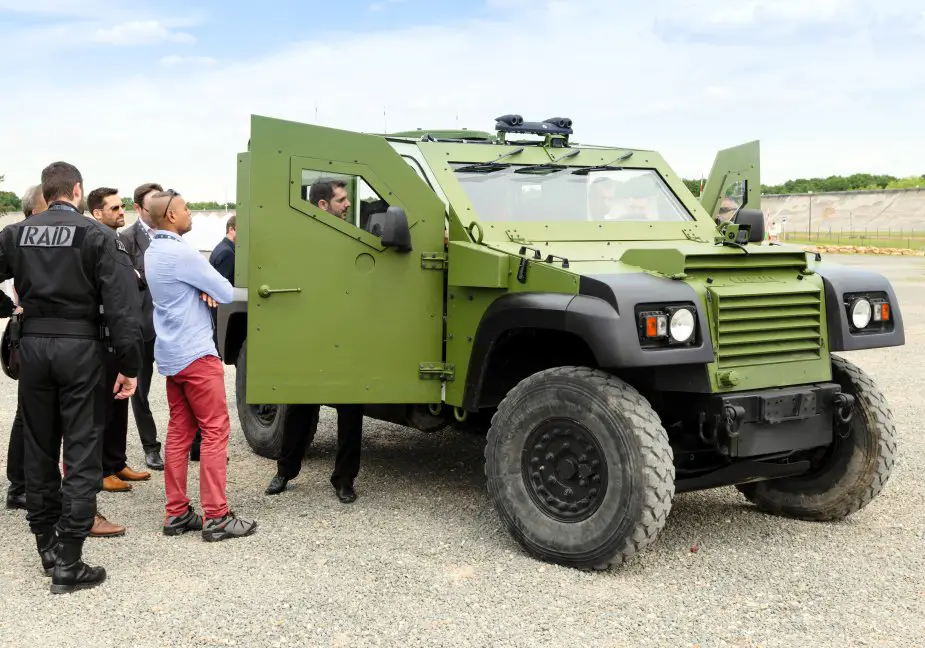
Remotely controlled Dagger (Picture source: Arquus)
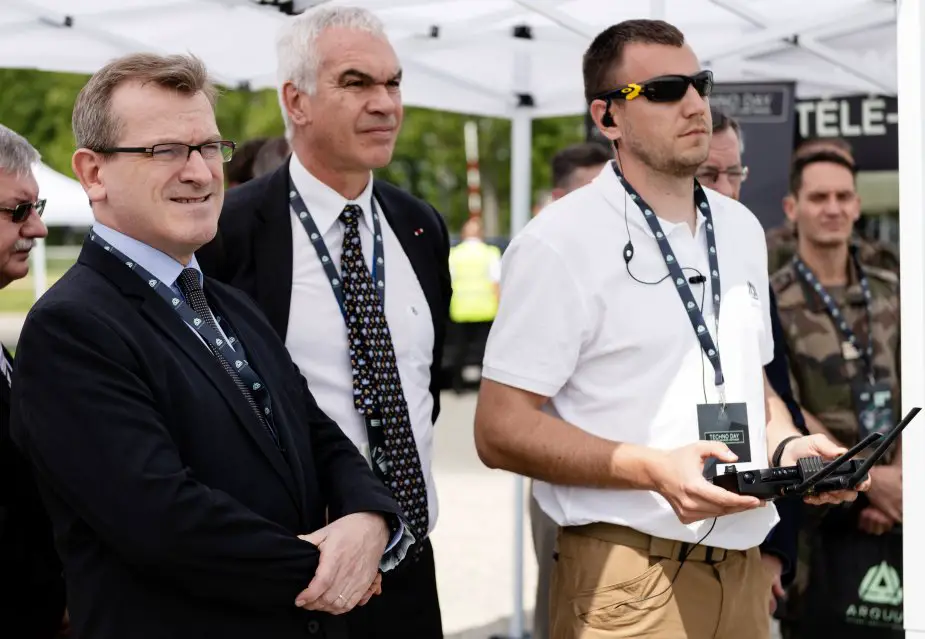
Emmanuel Levacher (left), CEO of Arquus, with the operator of the remotely controlled Dagger (Picture source: Arquus)
Protection is also a major concern for Arquus. Hence the development of many different solutions involving both material and ergonomic factors.
Logistics is also an important research axis for Arquus. Augmented reality diagnostics in connection with the documentation created by the manufacturer considerably facilitates training and actual logistic maintenance.
Mobility is of the utmost importance for both the army and, hence, Arquus. “Predictible mobility”, based on the use of drones with LIDAR to scan an intended itinerary and check its free access and ground nature acceptability with go/no-go itineraries (including river beds) is progressing, Arquus working with four partners (BRGM, ONERA,…) treating an aspect each, involving artificial intelligence to validate the results and self-learning. Demonstrations on PC are stunning! Military factors will later be included in the tests.
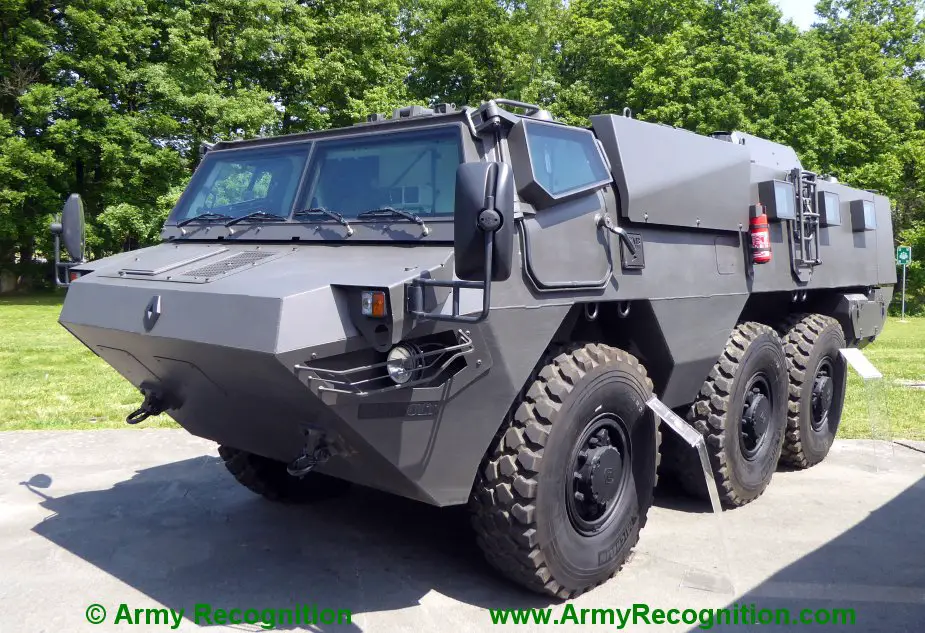
VAB Mk.3 Electer (Picture source: Army Recognition)
Research work in the energy sector is crucial, both in the logistical and tactical perspectives, the goal being to enable a military unit to be self-reliant for a 3-day combat situation without any resupply. The VAB Mk.3 Electer (Roman goddess having given her name to electricity) is the result of a request from the DGA (Direction Générale de l’Armement) for hybrid motorization. Fuel savings obtained by Arquus with its VAB Electer have progressed from 6 to 38% as more and more solutions were designed and implemented, be it in the vehicle wiring, air cooling system, special tires, hoses, solar panels on the roof, electric energy storage, turbo, combat compartment thermal insulation, various components design, etc. More is expected. So far, 78 kW can be produced to power the vehicle systems and external devices, without that any of these improvements would increase the total vehicle weight. Roughly speaking, Arquus has reached a 38% saving in energy consumption so far. 40% seems attainable.
As more and more manufacturers state, hydrogen is THE energy of the future, namely to enable a 3-day autonomy on the battlefield, not electricity. So, Arquus is on the ball with diesel-hydrogen engines in sight.

The Trigger, armed with a 12.7mm machine gun, was one of the vehicles displayed by Arquus at Montlhéry (Picture source: Army Recognition)

Beside off-road driving, the guests took part to demonstrations involving various Arquus armored vehicles driving at speeds nearing 100 km/h: Fortress and VAB Mk.3, Sherpas,... (Picture source: Army Recognition)


























